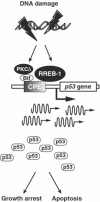The cell death machinery governed by the p53 tumor suppressor in response to DNA damage
- PMID: 20132225
- PMCID: PMC11158978
- DOI: 10.1111/j.1349-7006.2010.01488.x
The cell death machinery governed by the p53 tumor suppressor in response to DNA damage
Abstract
The cellular response to genotoxic stress that damages DNA includes cell cycle arrest, activation of DNA repair, and in the event of irreparable damage, induction of apoptosis. However, the signals that determine cell fate, that is, survival or apoptosis, are largely unclear. The tumor suppressor p53 has been implicated in many important cellular processes, including regulation of apoptotic cell death. When cells encounter genotoxic stress, certain sensors for DNA lesions eventually stabilize and activate p53. Subsequently, p53 exerts its tumor suppressor function by transactivating numerous target genes. Active p53 is subjected to a complex and diverse array of covalent post-translational modifications, which selectively influence the expression of p53 target genes. In this regard, the molecular basis for how p53 induces apoptosis has been extensively studied; however, the relative contribution of each downstream effector is still to be explored. Moreover, little is known about precise mechanisms by which modified p53 is capable of apoptosis induction. A thorough understanding for the whole picture of p53 modification in apoptosis will be extremely valuable in the development of highly effective and specific therapies for cancer patients. This review is focused on the current views regarding the regulation of cell fate by p53 in the apoptotic response to DNA damage.
Figures




Similar articles
-
Post-translational modifications of p53 tumor suppressor: determinants of its functional targets.Histol Histopathol. 2012 Apr;27(4):437-43. doi: 10.14670/HH-27.437. Histol Histopathol. 2012. PMID: 22374721 Review.
-
Living with p53, dying of p53.Cell. 2007 Aug 24;130(4):597-600. doi: 10.1016/j.cell.2007.08.005. Cell. 2007. PMID: 17719538 Review.
-
PKCdelta signaling: mechanisms of DNA damage response and apoptosis.Cell Signal. 2007 May;19(5):892-901. doi: 10.1016/j.cellsig.2007.01.027. Epub 2007 Feb 7. Cell Signal. 2007. PMID: 17336499 Review.
-
Determination of cell fate by c-Abl activation in the response to DNA damage.Oncogene. 1998 Dec 24;17(25):3309-18. doi: 10.1038/sj.onc.1202571. Oncogene. 1998. PMID: 9916993 Review.
-
[Cell cycle regulation after exposure to ionizing radiation].Bull Cancer. 1999 Apr;86(4):345-57. Bull Cancer. 1999. PMID: 10341340 Review. French.
Cited by
-
ROS-Mediated Cancer Cell Killing through Dietary Phytochemicals.Oxid Med Cell Longev. 2019 May 14;2019:9051542. doi: 10.1155/2019/9051542. eCollection 2019. Oxid Med Cell Longev. 2019. PMID: 31217841 Free PMC article. Review.
-
Comprehensive Management of Stroke: From Mechanisms to Therapeutic Approaches.Int J Mol Sci. 2024 May 11;25(10):5252. doi: 10.3390/ijms25105252. Int J Mol Sci. 2024. PMID: 38791292 Free PMC article. Review.
-
IND-2, a Quinoline Derivative, Inhibits the Proliferation of Prostate Cancer Cells by Inducing Oxidative Stress, Apoptosis and Inhibiting Topoisomerase II.Life (Basel). 2022 Nov 14;12(11):1879. doi: 10.3390/life12111879. Life (Basel). 2022. PMID: 36431014 Free PMC article.
-
Signature based on RNA-binding protein-related genes for predicting prognosis and guiding therapy in non-small cell lung cancer.Front Genet. 2022 Sep 2;13:930826. doi: 10.3389/fgene.2022.930826. eCollection 2022. Front Genet. 2022. PMID: 36118863 Free PMC article.
-
Crosstalk Between the Oxidative Stress and Glia Cells After Stroke: From Mechanism to Therapies.Front Immunol. 2022 Feb 25;13:852416. doi: 10.3389/fimmu.2022.852416. eCollection 2022. Front Immunol. 2022. PMID: 35281064 Free PMC article. Review.
References
-
- Yoshida K. Nuclear trafficking of pro‐apoptotic kinases in response to DNA damage. Trends Mol Med 2008; 14: 305–13. - PubMed
-
- Hollstein M, Sidransky D, Vogelstein B, Harris CC. p53 mutations in human cancers. Science 1991; 253: 49–53. - PubMed
-
- Shieh SY, Ikeda M, Taya Y, Prives C. DNA damage‐induced phosphorylation of p53 alleviates inhibition by MDM2. Cell 1997; 91: 325–34. - PubMed
-
- Oren M, Damalas A, Gottlieb T et al. Regulation of p53: intricate loops and delicate balances. Biochem Pharmacol 2002; 64: 865–71. - PubMed
-
- Donehower LA, Harvey M, Slagle BL et al. Mice deficient for p53 are developmentally normal but susceptible to spontaneous tumours. Nature 1992; 356: 215–21. - PubMed
Publication types
MeSH terms
Substances
LinkOut - more resources
Full Text Sources
Research Materials
Miscellaneous

